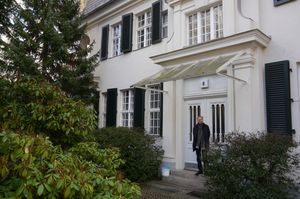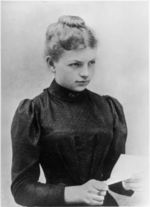

Historical Review on Clara Immerwahr's Life
Interview with Professor Friedrich about Clara Immerwahr
11 February 2016
Dear Professor Friedrich,
You have written an article, jointly with Dieter Hoffmann from the Max Planck Institute for the History of Science, about Clara Immerwahr, the first wife of Fritz Haber.
What was your motivation for writing this article?
Our article with Dieter about Clara Haber, nee Immerwahr is an exercise in the history of science, a field I’ve been dabbling in for the last two decades. I’ve written mainly on the emergence of quantum mechanics and on the rise of physical and theoretical chemistry, but also produced some biographical pieces, among them on Fritz Haber.
Fritz Haber is not only one of the most significant scientists of modern times, but also one of the most controversial ones. He not only laid the scientific foundations for the Haber-Bosch process whereby he secured an unlimited supply of fertilizer – and thereby of “bread from air”.
But he also applied himself in extraordinary ways to aid the German war effort in World War I and became the “father of chemical warfare” in the process. The night he celebrated the “success“ of deploying “poison instead of air“ at Ypres, Clara, herself a chemist, committed suicide.
However, your article about Clara Haber is concerned with her life, scientific work and legacy?
Yes, in order to provide as balanced an account as we could, we took a critical look at the available sources in general and examined the “myth of Clara Immerwahr” in particular. This myth took root in the 1990s and has shaped her public image until this day.
According to this myth, Clara was an outspoken pacifist, not unlike the 1905 Nobel Peace Prize laureate Bertha von Suttner, and a star scientist, not unlike Marie Curie, who was destroyed – as both a person and a scientist – by her oppressive and opportunistic husband, Fritz Haber, portrayed as a kind of Dr. Evil.
Do you want to rehabilitate Fritz Haber?
This article is not about Fritz Haber, but about Clara.
We believe that what Clara achieved in her time does not need to be embellished with exaggerations or even wishful thinking fashioned by present-day aspirations.
The impetus for our article about Clara Haber came from the German Ambassador to the Organisation for the Prohibition of Chemical Weapons in The Hague, Dr. Christoph Israng, who invited us to give a talk about her. Dieter Hoffmann and I tried to do our best to sift through the historical evidence and to limit our account to what can be said about Clara with reasonable confidence.
The title of your article is Clara Haber, nee Immerwahr, why?
This is very intentional, because the name of Fritz Haber’s wife was actually Clara Haber and referring to her by her maiden name amounts to a certain collusion with the myth.
What role played the Fritz Haber Institute in creating the myth? The memorial stone for her on the ground of the institute close to the Haber Villa is written “In Memory of Clara Immerwahr”?
That is true. I would say that people got so much used to the name “Clara Immerwahr” that they may have forgotten that this was actually not her name when she was Haber's wife. As for the memorial in the garden of the institute, perhaps a more fitting inscription would be Dr. Clara Haber, nee Immerwahr. And, the doctoral title should I think not be omitted for it refers to such an important aspect of her life.
But to answer your question: I don’t think that the Fritz Haber Institute played essentially any role in creating the myth.
In 1993, Gerit von Leitner published the book “Der Fall Clara Immerwahr. Leben für eine humane Wissenschaft” which was widely read in Germany. What do we have to consider differently now?
The book by Gerit von Leitner was criticized quite a bit already after its release, but few people listened to the critics. Apparently, the book struck a chord with the Zeitgeist and served as a vehicle for furthering the opinions and ideals of the peace movement, feminism and antimilitarism. In von Leitner’s book, Clara’s attempt to have a self-determined life as a woman, mother and scientist as well as her tragic suicide are interpreted as a beacon of a feminine, life-preserving science and juxtaposed with the male, patriarchal power-oriented science concerned with the exploitation of resources. Although von Leitner’s book as well as its numerous derivatives force such an interpretation on us, the available scholarly sources in no way support it.
I personally find the story dramatically appealing – especially in some of its dramatizations. The problem is that the largely fictitious story uses the names of real persons. And it glorifies one of them while damning the other.
That von Leitner’s portrait of Clara was belletristic has been well known to historically minded readers and historians alike, in particular to the author of the authoritative Haber biography, Margit Szöllösi-Janze. In her masterful work, published in 1998, Szöllösi-Janze provides a critical evaluation of the sources about Clara. It’s a shame that it is not better known to the public and has not been translated into English.
Do you have additional sources, now?
Yes, recently the correspondence between Clara Haber and Fritz Haber’s collaborator Setsuro Tamaru and the yet unpublished letters of Edith Hahn to her husband Otto and of Lise Meitner to Edith Hahn have been made available. All these recently surfaced letters are particularly hard to reconcile with the image of Clara as an outspoken pacifist, who committed suicide because of her disagreements with her husband about the conduct of the war in general and chemical warfare in particular.
What was the content of Setsuro Tamaru’s letter to Clara?
Setsuro Tamaru had to leave Germany after the outbreak of WWI and in his letter from Christmas Eve, 1914 he complained bitterly about the war’s politics.
The letter was made available to me recently by the Tamaru family through Setsuro Tamaru’s granddaughter, Hideko Tamaru Oyama, a Professor of Chemistry at Rikkyo University in Tokyo. It was not known to what the letter of Clara to Tamaru from January 15, 1915 was responding.
Clara’s reply is revealing in several respects: Firstly, she describes her own patriotic feeling and a need to be “helpful” and “useful” to her country; Secondly, she mentions that her husband was working “18 hour days” and that she herself was taking care of “57 poor children” - apparently children whose fathers were on the front - while her son Hermann had been “constantly sick since November;” Thirdly, she glosses over Tamaru’s litany about the political situation and describes herself as „too ignorant in the matters of foreign affairs to be able to properly reply“ to it.
What is new in the letters of Edith Hahn and Lise Meitner?
Sadly, these letters indicate that Clara was perceived as a person out of place in Dahlem and that she was known to have complained about being neglected by her husband. These letters were written within 14 days of Clara’s suicide, on May 2, 1915. Professor Eckart Henning, the former Director of the Max Planck Archive, will publish these letters along with his commentary, hopefully back to back with our paper.
So, Clara Haber did not commit suicide because of her opposition to chemical warfare?
That seems to be the impression shared by most people familiar with the historical sources, including ourselves. It seems that the “catastrophic failure” - to borrow a term from engineering as a metaphor - resulted from a most unfortunate confluence of circumstances that included, apart from what was Clara’s unfulfilling life, Haber’s philandering, the death of her PhD adviser Richard Abegg and another close friend of Clara’s, the physical chemist Otto Sackur, and the death and destruction of the war itself.
What is the origin of the myth of Clara Immerwahr?
Apparently, it all began in the early 1940s in the U.S., when a fellow of the name Morris Goran started stalking German émigré scientists. We don't know whether Goran, who was neither a scientist nor a historian, worked for himself or for an agency. One of the scientists whom Goran sought to interview was a former Haber collaborator, James Franck. Franck later stated that he had declined to talk to Goran and characterized him as someone who wanted to aggrandize himself by publishing a book about a great man such as Fritz Haber. This did not prevent Goran from including Franck among his sources.
Goran published in 1947 a biographical article about Haber and in 1967 a book entitled The Story of Fritz Haber, where he stated that Clara was “vitally affected” by her husband’s involvement in WWI chemical warfare and committed suicide after a heated argument with Fritz about what she considered to be “a perversion of science” and “a sign of barbarism.“ Goran gives no evidence or sources for either this scenario or these statements. Apparently, the much-quoted phrase about the perversion of science and barbarism, ascribed to Clara, is Goran’s own. On the remainder of roughly three pages that he dedicated to Clara of the two-hundred-page Haber biography, Goran also points out that she was depressive. Although Goran doesn’t give any references here either, most of the available sources suggest that Clara was indeed depressive and that the depressions that hit her in her later life had to do with her unhappy and unfulfilling married life on the side of Fritz Haber.
Goran’s ill-founded scenario about Clara’s suicide as being connected with Fritz Haber’s involvement in chemical warfare was then appropriated and amplified by Gerit von Leitner in her widely read book Der Fall Clara Immerwahr.
Was there a chance for Clara to go back to science, to return to the laboratory and do research?
That’s a good question. Apart from societal barriers that made it virtually impossible for women in turn-of-the-century Prussia to find employment as scientists/chemists, Clara’s son Hermann, born in 1902, a year after Fritz and Clara were married, was a sickly child, who required a lot of care. And Clara had become sickly as well. Moreover, until Fritz Haber’s promotion to full professorship in 1906, the Habers were not well off and Clara had to do most of the household work by herself. Nevertheless, so long as her health and that of her son had permitted, Clara freelanced as an instructor in the continued education of women, mostly housewives, while struggling not to become a housewife herself.
In a letter from 1901 to Richard Abegg, Clara declared that she will get back to the laboratory „… once we become millionaires and will be able to afford servants. Because I cannot even think about giving up my [scientific work].“ As we know, the Habers did become rich, but Clara would never return to the laboratory nevertheless. As years went by, she would fall increasingly into the traditional role of a representative professorial wife, a housewife preoccupied with the well-being of the family and a caring mother. This was aggravated by Haber’s dog-eat-dog mentality and his obsession with his work and career, which left little room for Clara’s professional development and reduced her more and more to a house-mother.
However, Fritz Haber had something to show for his workaholism – and Clara, like anybody familiar with Haber’s work, must have been well aware of it. The discovery of the catalytic synthesis of ammonia is but one of many of Haber’s achievements, albeit perhaps the most significant among those that “have conferred a benefit to mankind.”
Would you think, if Fritz had been a woman and Clara had been a man, would Clara have become the director of the Kaiser Wilhelm Institute and Fritz just a “house-man”?
Perhaps. I don’t know how much genius for science Clara had shown before her marriage. But I don’t have a good sense for how much of a prodigy Fritz Haber had been either. However, in his first academic job, at the Technische Hochschule Karlsruhe, he became extremely accomplished very quickly. His slow promotion to the rank of a full professor was perceived as a scandal in some quarters – and a manifestation of anti-Semitism.
In the last chapter Gerit von Leitner claims that Clara wrote a farewell letter before committing suicide and that the housekeepers had seen the letter but that it was destroyed. Did you find any farewell letter of Clara Immerwahr?
No, there is no such letter.
Could you personally imagine that Clara wrote a farewell letter? Do you know the statistics of how many suicide victims write farewell letters?
I’m sorry, but I’m quite ignorant about the sociology of suicides. If it’s true that, as Hermann Lütge, the fine-mechanic, had testified, Clara found her husband during the fateful night in flagranti with another woman, it’s not too difficult to imagine that she had been quite distraught. I don’t know whether people in such situations write farewell letters. More to the point, I have no knowledge of whether Clara wrote such a letter.
Lütge gave his testimony 40 years afterwards. In flagranti with Charlotte Nathan, who would become Haber’s second wife?
Apparently.
And she, Charlotte Haber, had denied having been in the Haber mansion on May 2nd 1915.
Yes, Charlotte contradicted it in her memoirs, published in 1970, by stating the year of her acquaintance with Haber as 1917. However, given her job at the club “Deutsche Gesellschaft 1914,“ Fritz Haber, an early member, and Charlotte must have known each other since about 1914.
Where, in which journal will your article be published?
We submitted the article to Zeitschrift für Allgemeine und Anorganische Chemie, which published an article on Clara in 2012. Moreover, in 1900, Zeitschrift für Anorganische Chemie was the venue for the publication of one of Clara's own papers.
What do you think is Clara Haber’s legacy?
Clara’s admirable feat of graduating in chemistry with magna cum laude in a 1900 Prussia was not only unusual but also difficult, or unusual because it was difficult. It took the first thirty years of her life to achieve it, for she was denied a straight path, free of hurdles and chicanes, and had to take lengthy detours. Nowadays, many leading universities attained parity in the numbers of male and female students. And there are many female scientists as a result, although there could be more, especially in the hard sciences – as well as in the leading positions in academia and other walks of life. It is worth remembering that Clara’s case helped to achieve it. Better still, it is worth to remember Clara and help to achieve the rest.
Thank you very much for the interview.

Prof. Bretislav Friedrich has been a Research Group Leader at the Fritz Haber Institute since 2003 and Honorarprofessor at the Technische Universität Berlin since 2006. His research in molecular/chemical physics is mainly concerned with interactions of molecules with and in electric, magnetic, and optical fields and their combinations.
Bretislav Friedrich has written over 170 scientific articles, published in high-ranking peer-reviewed journals and cited over 7000 times.
More Information on Bretislav Friedrich
www.fhi-berlin.mpg.de/mp/friedrich/
The interview was conducted by Dr. Martin Penno.
All photos except Clara Immerwahr: © UniCat / TU Berlin / Martin Penno

Postscript: The scientific articles have been published online on 11 March 2016.
Clara Haber, nee Immerwahr (1870–1915): Life, Work and Legacy
Bretislav Friedrich and Dieter Hoffmann
Zeitschrift für anorganische und allgemeine Chemie, Volume 642, 437–448, 2016
DOI: 10.1002/zaac.201600035
Freitod in Dahlem (1915): Unveröffentlichte Briefe von Edith Hahn und
Lise Meitner über Dr. Clara Haber geb. Immerwahr
Eckart Henning
Zeitschrift für anorganische und allgemeine Chemie, Volume 642, 432–436, 2016
DOI: 10.1002/zaac.201600052






